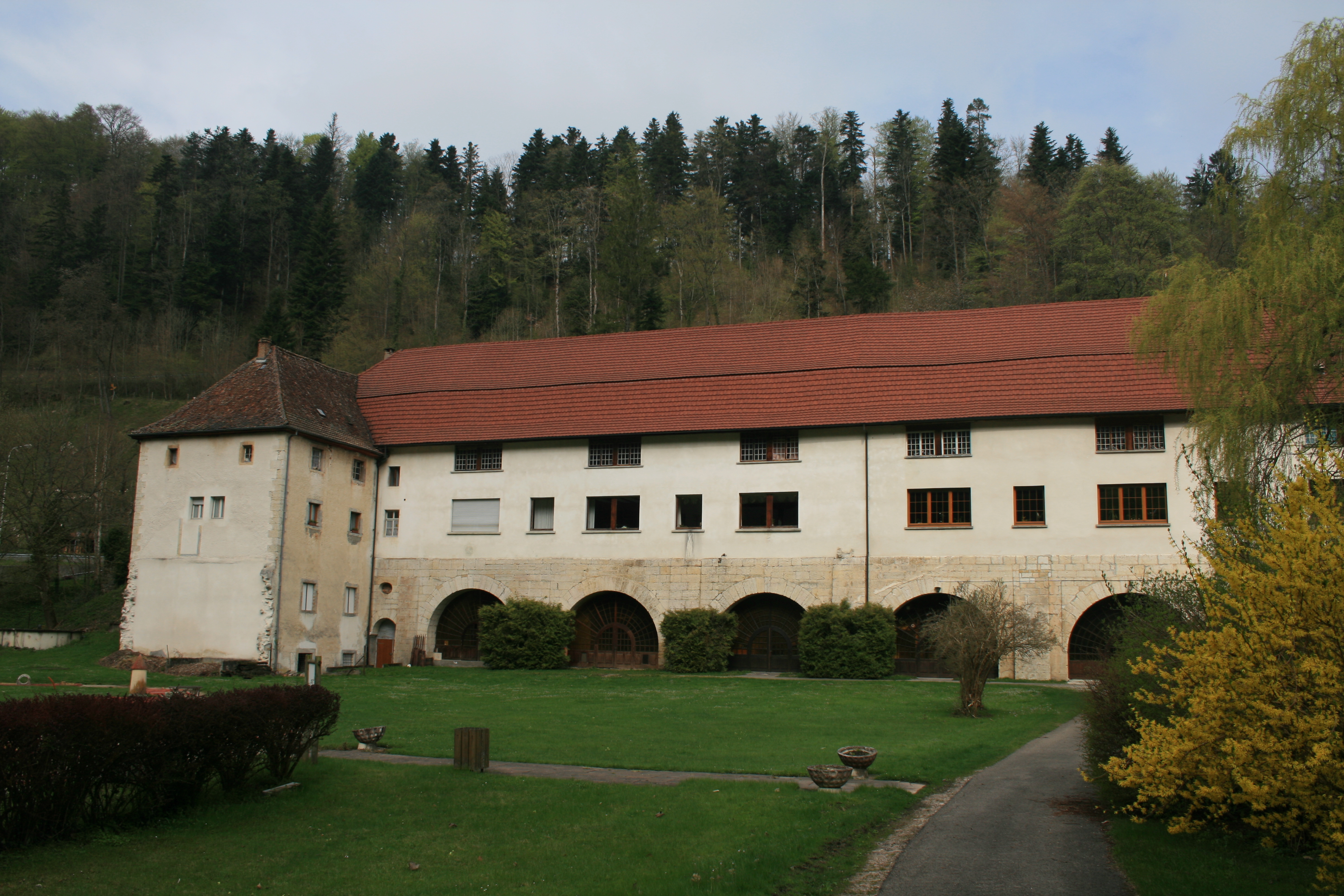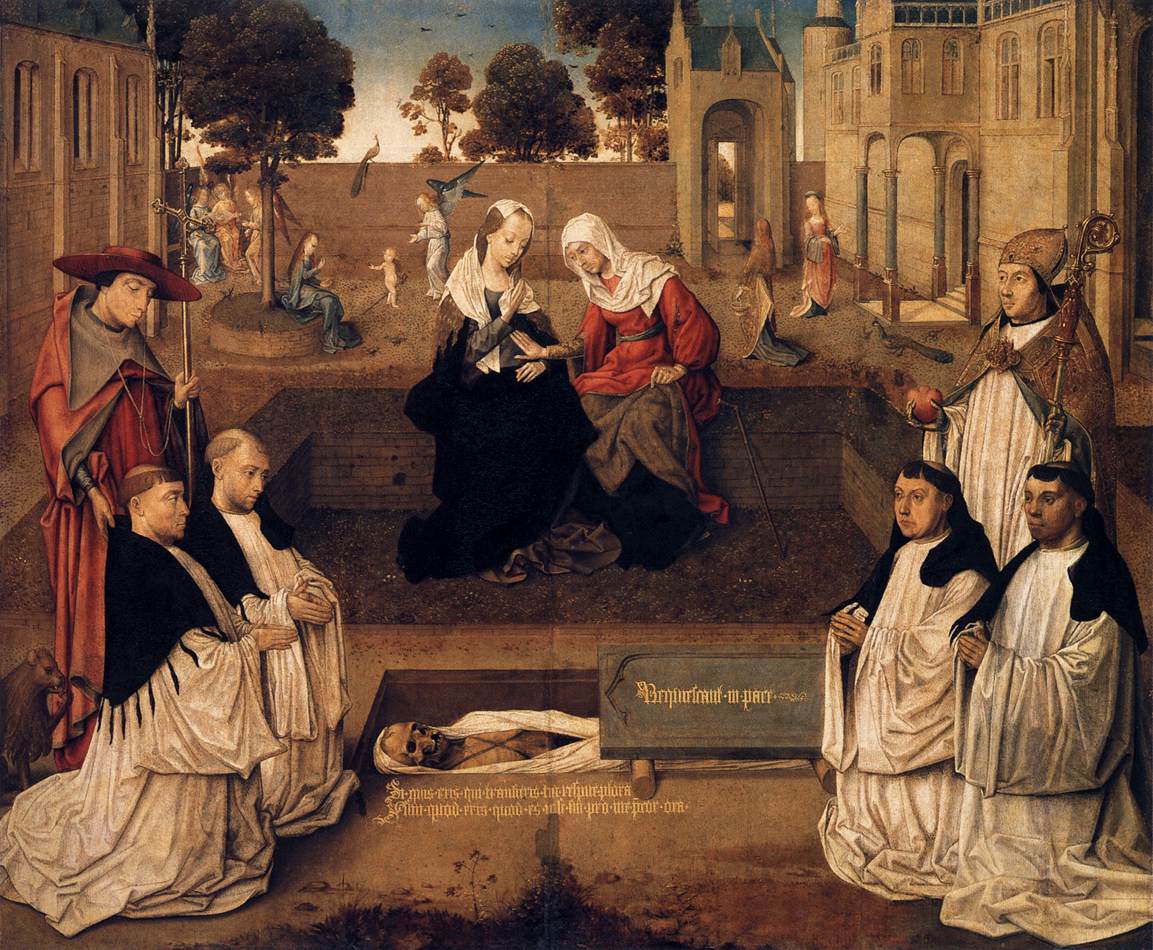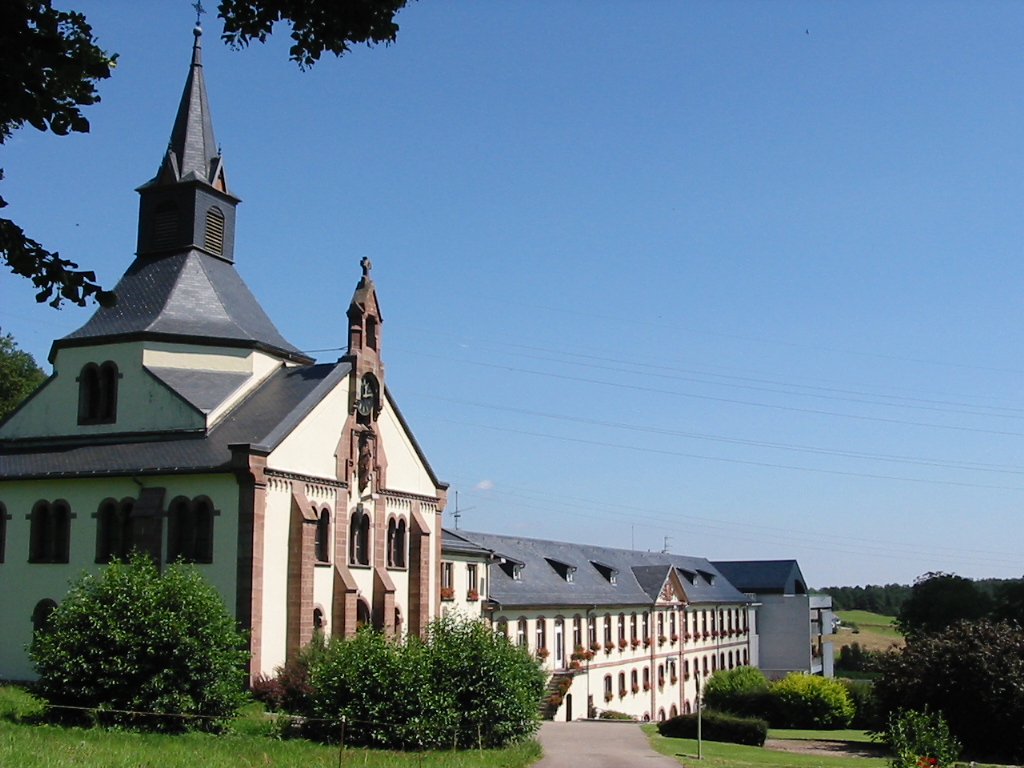|
Lucelle Abbey
Lucelle Abbey or Lützel Abbey (; ) was a Cistercian monastery in the present village of Lucelle, in the Haut-Rhin department in Alsace, France, but located right on the Swiss border. The name of the original foundation was ''Lucis cella'', the "cell of light". Lucelle was founded in 1124 as a daughter house of Bellevaux Abbey, which in its turn was a daughter house of Morimond Abbey. It was dissolved in 1792 during the French Revolution. Daughter houses The following were daughter houses settled from Lucelle: * Neubourg Abbey (1130/1131) * Kaisheim Abbey (1133) * Lieu-Croissant Abbey (1134) * Salem Abbey (1134/1137 or 1138) * Frienisberg Abbey (1131/1138) * Pairis Abbey (1139) * St. Urban's Abbey (1194) Lützel Abbey seems also to have founded a small Cistercian nunnery, Kleinlützel Priory in Switzerland, in about 1136–1138, although there is no direct evidence that they did so or that the women's community at Kleinlützel was Cistercian. In 1264 the foundation w ... [...More Info...] [...Related Items...] OR: [Wikipedia] [Google] [Baidu] |
Lucelle Alsace 027
Lucelle () is a village situated on the Franco-Swiss border. It is divided between the two countries, the northern half (47 inhabitants in 1999) being part of the commune of Lucelle, Haut-Rhin, in the Haut-Rhin department, the southern half being part of Pleigne, in the Swiss Canton of Jura. An important Cistercian monastery, Lucelle Abbey Lucelle Abbey or Lützel Abbey (; ) was a Cistercian monastery in the present village of Lucelle, in the Haut-Rhin department in Alsace, France, but located right on the Swiss border. The name of the original foundation was ''Lucis cella'', th ..., was located here from the early 12th to the late 18th century. Geography of Haut-Rhin France–Switzerland border crossings Villages in Grand Est {{JuraCH-geo-stub ... [...More Info...] [...Related Items...] OR: [Wikipedia] [Google] [Baidu] |
Salem Abbey
Salem Abbey () was a very prominent Cistercian monastery at Salem in the district of Bodensee, about ten miles from Konstanz in Baden-Württemberg, Germany. The buildings are now owned by the State of Baden-Württemberg and are open for tours as the Salem Monastery and Palace. History In 1134, a knight named Guntram von Adelsreute, inspired by a sermon held by Bernard of Clairvaux at the Konstanz Minster, donated an estate in the Linzgau region to Bernard's monastic order, the Cistercians. That estate, called the Salmannsweiler, had an area of about and was too small to support a monastery. Regardless, in 1137 a party of 12 monks were sent from Lucelle Abbey, in Alsace. These monks combined existing farms with further donations from Guntram in 1138 that gave the new monastery a stable economic base. Its abbot, Frowin, a friend of Bernard, named the monastery Salem, likely as an allusion to Jerusalem. The foundation of the abbey was confirmed by Linzgau nobility led by the ... [...More Info...] [...Related Items...] OR: [Wikipedia] [Google] [Baidu] |
1124 Establishments In Europe
Eleven or 11 may refer to: *11 (number) * One of the years 11 BC, AD 11, 1911, 2011 Literature * ''Eleven'' (novel), a 2006 novel by British author David Llewellyn *''Eleven'', a 1970 collection of short stories by Patricia Highsmith *''Eleven'', a 2004 children's novel in The Winnie Years by Lauren Myracle *''Eleven'', a 2008 children's novel by Patricia Reilly Giff *''Eleven'', a short story by Sandra Cisneros Music *Eleven (band), an American rock band * Eleven: A Music Company, an Australian record label *Up to eleven, an idiom from popular culture, coined in the movie ''This Is Spinal Tap'' Albums * ''11'' (The Smithereens album), 1989 * ''11'' (Ua album), 1996 * ''11'' (Bryan Adams album), 2008 * ''11'' (Sault album), 2022 * ''Eleven'' (Harry Connick, Jr. album), 1992 * ''Eleven'' (22-Pistepirkko album), 1998 * ''Eleven'' (Sugarcult album), 1999 * ''Eleven'' (B'z album), 2000 * ''Eleven'' (Reamonn album), 2010 * ''Eleven'' (Martina McBride album), 2011 * ''Eleven'' (Mr Fogg ... [...More Info...] [...Related Items...] OR: [Wikipedia] [Google] [Baidu] |
Buildings And Structures In Haut-Rhin
A building or edifice is an enclosed structure with a roof, walls and windows, usually standing permanently in one place, such as a house or factory. Buildings come in a variety of sizes, shapes, and functions, and have been adapted throughout history for numerous factors, from building materials available, to weather conditions, land prices, ground conditions, specific uses, prestige, and aesthetic reasons. To better understand the concept, see ''Nonbuilding structure'' for contrast. Buildings serve several societal needs – occupancy, primarily as shelter from weather, security, living space, privacy, to store belongings, and to comfortably live and work. A building as a shelter represents a physical separation of the human habitat (a place of comfort and safety) from the ''outside'' (a place that may be harsh and harmful at times). buildings have been objects or canvasses of much artistic expression. In recent years, interest in sustainable planning and building practi ... [...More Info...] [...Related Items...] OR: [Wikipedia] [Google] [Baidu] |
Cistercian Monasteries In France
The Cistercians (), officially the Order of Cistercians (, abbreviated as OCist or SOCist), are a Catholic religious order of monks and nuns that branched off from the Benedictines and follow the Rule of Saint Benedict, as well as the contributions of the highly influential Bernard of Clairvaux, known as the Latin Rule. They are also known as Bernardines, after Bernard of Clairvaux, Saint Bernard, or as White Monks, in reference to the colour of their cowl, as opposed to the black cowl worn by Benedictines. The term ''Cistercian'' derives from ''Cistercium,'' the Latin name for the locale of Cîteaux, near Dijon in eastern France. It was here that a group of Benedictine monks from the monastery of Molesme Abbey, Molesme founded Cîteaux Abbey in 1098. The first three abbots were Robert of Molesme, Alberic of Cîteaux and Stephen Harding. Bernard helped launch a new era when he entered the monastery in the early 1110s with 30 companions. By the end of the 12th century, the ord ... [...More Info...] [...Related Items...] OR: [Wikipedia] [Google] [Baidu] |
Augustinian Canons
The Canons Regular of St. Augustine are Catholic priests who live in community under a rule ( and κανών, ''kanon'', in Greek) and are generally organised into religious orders, differing from both secular canons and other forms of religious life, such as clerics regular, designated by a partly similar terminology. As religious communities, they have laybrothers as part of the community. At times, their Orders have been very popular: in England in the 12th century, there were more houses of canons (often referred to as an abbey or canonry) than monasteries of monks. Preliminary distinctions All canons regular are to be distinguished from secular canons who belong to a resident group of priests but who do not take public vows and are not governed in whatever elements of life they lead in common by a historical rule. One obvious place where such groups of priests are required is at a cathedral, where there were many Masses to celebrate and the Divine Office to be pray ... [...More Info...] [...Related Items...] OR: [Wikipedia] [Google] [Baidu] |
Switzerland
Switzerland, officially the Swiss Confederation, is a landlocked country located in west-central Europe. It is bordered by Italy to the south, France to the west, Germany to the north, and Austria and Liechtenstein to the east. Switzerland is geographically divided among the Swiss Plateau, the Swiss Alps, Alps and the Jura Mountains, Jura; the Alps occupy the greater part of the territory, whereas most of the country's Demographics of Switzerland, 9 million people are concentrated on the plateau, which hosts List of cities in Switzerland, its largest cities and economic centres, including Zurich, Geneva, and Lausanne. Switzerland is a federal republic composed of Cantons of Switzerland, 26 cantons, with federal authorities based in Bern. It has four main linguistic and cultural regions: German, French, Italian and Romansh language, Romansh. Although most Swiss are German-speaking, national identity is fairly cohesive, being rooted in a common historical background, shared ... [...More Info...] [...Related Items...] OR: [Wikipedia] [Google] [Baidu] |
Kleinlützel Priory
Kleinlützel Priory was a small religious house at Kleinlützel, a community in the district of Thierstein in the Canton of Solothurn in Switzerland. During the course of its history it housed several different religious communities. History The early history of the priory is poorly documented. In about 1136-1138 a small women's religious community, the ''Minor Lucella'', was established.near the present "Klösterli" There is no firm evidence that this was a community of Cistercian nuns, but the similarity of names strongly suggests that it was a foundation or dependency of the Cistercian Lützel Abbey (''Lucella''), which clearly had a connection with the place. The establishment was transferred in 1264 to the Canons Regular of the Priory of St. Leonhard in Basel. In 1486 it became a house of Canonesses Regular, who relocated in 1494 or 1495 to Schwarzenthann, where they remained until their community was suppressed in 1530. The buildings at Kleinlützel suffered serious damage ... [...More Info...] [...Related Items...] OR: [Wikipedia] [Google] [Baidu] |
Cistercian Nunnery
Cistercian nuns are female members of the Cistercian Order, a religious order of the Catholic Church. History The Cistercian Order was initially a male order. Cistercian female monasteries began to appear by 1125. The first Cistercian monastery for women, Le Tart Abbey, was established at Tart-l'Abbaye in the Diocese of Langres (now Dijon) in 1125, by nuns from the Benedictine monastery of Juilly, and with the cooperation of Stephen Harding, abbot of Cîteaux. At Juilly, a dependency of Molesme Abbey, Humbeline, the sister of Saint Bernard of Clairvaux, lived and died.Herbermann, Charles, ed. (1913). " Cistercian Sisters". ''Catholic Encyclopedia''. New York: Robert Appleton Company. The Cistercian nuns of Le Tart founded daughter houses in Europe, including at Ferraque (1140) in the Diocese of Noyon, Blandecques (1153) in the Diocese of St-Omer, and Montreuil-les-Dames (1164) near Laon. Charity work was central to the activities of the Cistercian nunneries, and some ... [...More Info...] [...Related Items...] OR: [Wikipedia] [Google] [Baidu] |
Pairis Abbey
Pairis Abbey is a former Cistercian monastery in Orbey in Haut-Rhin, Alsace, northeastern France. The surviving building serves today as a nursing home. The abbey was founded in 1138 by the Count of Eguisheim as a daughter house of Lucelle Abbey. In the 13th century, abbot Martin of Pairis preached the Fourth Crusade and then participated in the misfire of it. After taking active part in the sacking of Constantinople, Martin brought several looted relics from there to Pairis, increasing the status of the monastery considerably. The monk Gunther of Pairis wrote an account of the crusade. The abbey was joined to the Abbey of Maulbronn in 1452, confirmed by the Cistercian general chapter in 1453 and Pope Pius II in 1461. In 1648, Maulbronn was turned over to the Protestant Duchy of Württemberg by the Peace of Westphalia. The Cistercians were forced to leave and they re-established the abbey of Pairis.François Walter and Philippe André Grandidier, ''Vues pittoresques de l'Alsa ... [...More Info...] [...Related Items...] OR: [Wikipedia] [Google] [Baidu] |
Frienisberg Abbey
Frienisberg Abbey is a former Cistercian religious house in the Switzerland, Swiss municipalities of Switzerland, municipality of Seedorf, Bern, Seedorf in the Canton of Bern. History In 1131 Count Udelhard of Saugern granted his land at Frienisberg to the Cistercian Lützel Abbey. In 1138, the Lützel Abbey sent settlers to Frienisberg to found a new abbey. The new abbey remained small and struggled until the first half of the 13th century, when a number of donations allowed it to expand. In 1233 it owned land in Frienisberg, Allenwil, Ried, Tedlingen, Niederwiler, Werd, Gäserz bei Ins and Montils bei Nugerol. At its peak, about 300 farmers worked 5,000 ''Juchart'' (a measurement of acreage related to the Roman Jugerum, 1 Juchart was for a total of ) in 45 villages west of Bern. It also owned vineyards on the shores of Lake Biel and had 282 men working on the vines. Finally it controlled the patronage and the right to appoint parish priests in Rapperswil, Bern, Rapperswil, ... [...More Info...] [...Related Items...] OR: [Wikipedia] [Google] [Baidu] |
Lieu-Croissant Abbey
Lieu-Croissant Abbey () was a Cistercian abbey in Mancenans, a commune of Doubs in France. It was first built in 1134 and it was destroyed during the French Revolution in 1791. During the Crusades on the way from Milan to Cologne, the relics of the Magi were entrusted to the monks of this abbey, earning it the nickname Abbey of the Three Kings (). Notes Crusader churches Cistercian monasteries in France Buildings and structures in Doubs Christian monasteries established in the 1130s 1134 establishments in Europe {{France-Christian-monastery-stub ... [...More Info...] [...Related Items...] OR: [Wikipedia] [Google] [Baidu] |







